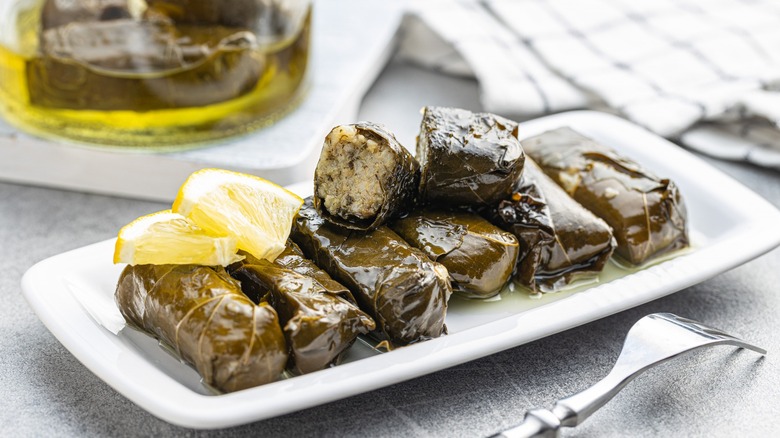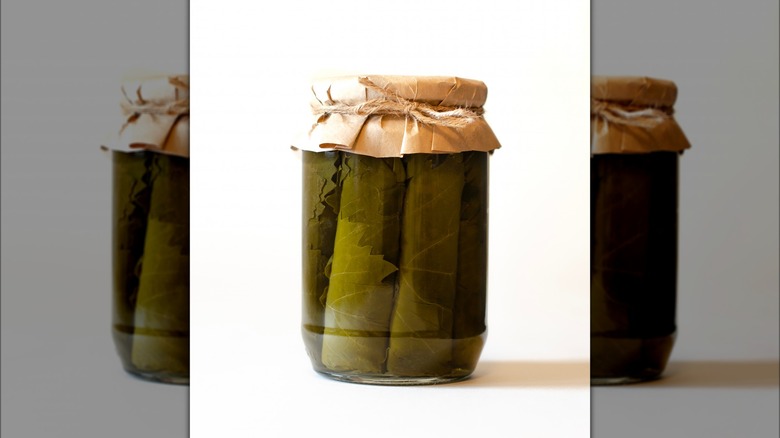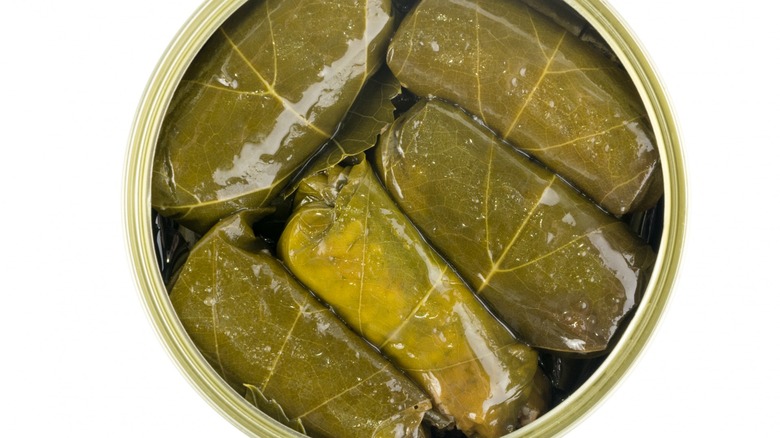Should You Rinse Canned Dolmas Before Eating Them?
If you've never had the chance to experience dolmas (also known as dolmades or dolmadakia), it's a dish worth seeking out. Although there is some contention as to where the blanched grape leaves — typically stuffed with rice, meats, and various herbs — originally hail from (some point to Greece, others Turkey and the Middle East or Armenia), they are surely worth trying.
Dolmas make a great meal, but can be tedious and time-consuming to prepare. As a result, some may opt out of making them from scratch, instead buying dolmas packaged in a can. In some ways, they can be just as good, but it might also raise a concern: Should canned dolmas be rinsed before consuming?
In short, yes. Canned Dolmas (or jarred grape leaves, for that matter) should be rinsed after opening, because products like these typically come brined. So, a quick wash will remove excess salt solutions, which could otherwise ruin the overall quality of the meal.
Why washing canned dolmas is a good idea
In the case of dolmas, as with most things, it's generally accepted that fresh is preferred over canned; they simply taste better. Still, fresh grape leaves can be hard to come by. The harvesting window only lasts about two months, and the leaves degrade quickly. So, persevered grape leaves or canned dolmas might at times be the only options available.
According to the Michigan State University Extension, no known "research-tested methods" exist for home-canning grape leaves due to the plant's low acidic levels, which can lead to botulism if canned incorrectly. While this can be avoided with a pressure canner, which heats low-acidic foods to the 240 degrees Fahrenheit needed to kill the spores that create the foodborne toxin, not many have one on hand, so perhaps buying canned from a reputable seller is the preferable.
As Chef Robin Hollis told Food&Wine, canned can be just as satisfying, "I've been eating a ton of grape leaves recently. They are so comforting and filling, a perfect salty little carb snack that isn't fried...[and] requires no cooking." It's smart to rinse off the brine, which is necessary for cooking and storing fresh leaves because it helps soften them. But a quick 10-minute cold water bath removes overly salty flavors. Additionally, buying canned dolmas might add further benefits since a study showed that the brine lowers the chances of any commercial pesticides remaining (which shouldn't be there in the first place, but mistakes happen).
Other things to consider when eating canned dolmas
While canned grape leaves and dolmas (which incidentally is one of the canned foods you should be buying from Trader Joe's) are typically ready-to-eat, some chefs have found ways to rinse them while adding a bit of flavor. Chef Jim Botsacos (per The New York Times) usually treats canned grape leaves with boiling water infused with lemon before placing them in an ice bath, while others use seasonings and flavoring agents to enrich the brine. Granted, in these instances, the experts worked with fresh or canned leaves and prepared the dolmas themselves. But the idea might also work for canned dolmas, with some tweaking.
For example, it wouldn't be recommended to prepare jarred dolmas the way Chef Botsacos got brined leaves ready, mainly because they're pre-rolled, and boiling could potentially tear them apart and make a mess. However, heating some water with herbs and other flavors and gently soaking the cylindrical tubes filled with rice and meat in the liquid to bring them up to temp may be beneficial. In theory, this practice should rinse off any brine, heat the dish, and imbue some aromatics into the leaves' exteriors. As a result, you can rinse the extra salt found in brined, canned dolmas (which you should) and add other tastes as well, making the commercial product your own.


